| The first municipal housing in Darlaston, was built in
1920 to the south of Herberts Park in Herberts Park Road
and Partridge Avenue. This was the beginning of a large
undertaking which finally improved the housing
conditions in the town. 3,500 council houses had been
built by 1965, nearly 2,000 of them in Bentley. Many
of the new housing estates had roads that were named
after local councillors, which became common practice.
Although most of the councillors have long been
forgotten, their surnames are well known thanks to roads
such as Wiley Avenue, Berry Avenue, Hall Street, Lowe
Avenue, and Stanbury Avenue.
| |
|
| Read about some
of the councillors who had roads named after
them |
 |
| |
|
After the war Emmanuel Hartsorne brought two army
surplus lorries, and founded the firm, E. Hartsorne &
Son Ltd. road transport contractors. They operated from
Springhead garage and by the early 1930s operated a
large fleet of vehicles specialising in long distance
haulage. Emmanuel died in 1939 and the business carried
on going from strength to strength. |
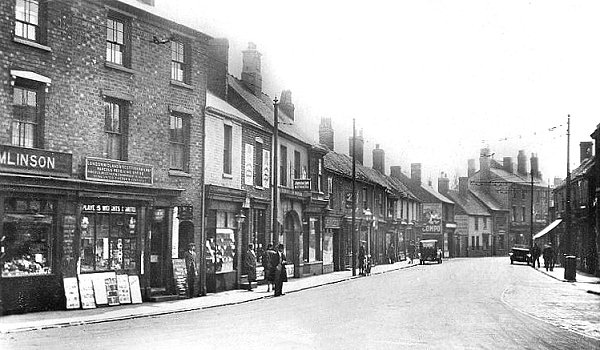 Pinfold Street in the 1920s. From
an old postcard.
Pinfold Street in the 1920s. From
an old postcard.
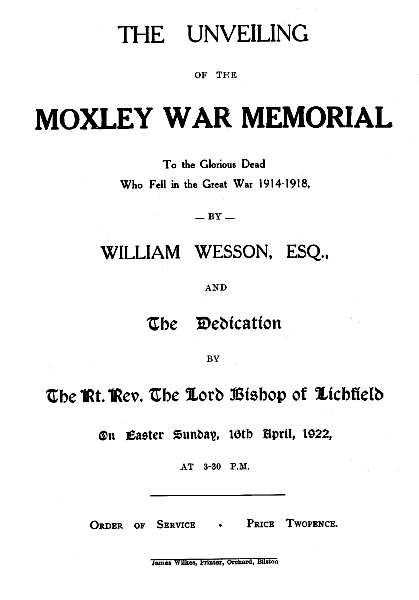 |
The programme for the
unveiling of Moxley war memorial, and the
service of dedication that took place on Sunday
16th April, 1922.
Courtesy of Christine &
John Ashmore.
In September 2013 the
memorial was rededicated after a £45,000
refurbishment that was paid for by Walsall
Council. The work included the installation of
plaques which carry the names of the local
people who gave their lives for their country
during the First World War. |
| George Rose
Park George Rose Park was named after John George Rose,
Chairman of the Council from 1911 to 1914, and 1919
until 1924. After the 1914-1918 war, unemployment in Darlaston
was high, with about 2,000 people out of work. George Rose introduced several schemes to find work
for them, one of which was the building of the park. Other schemes included the building of a new sewage
works, and the building of Midland Road from Darlaston
Green to Willenhall. |
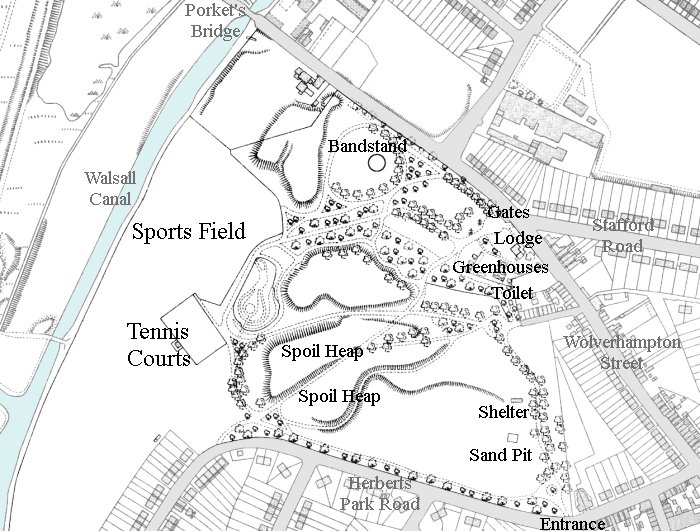
George Rose Park.
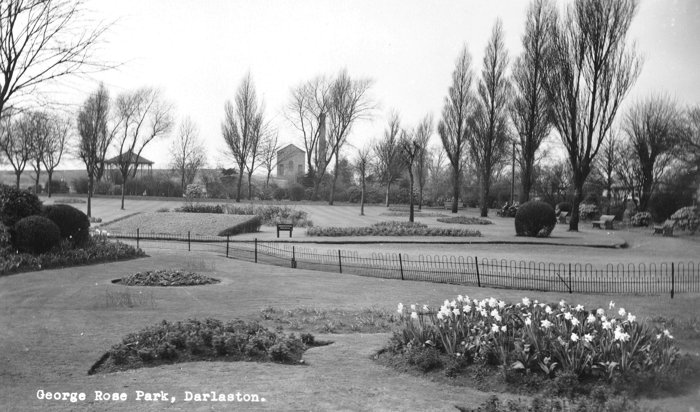
George Rose Park. From an old
postcard.
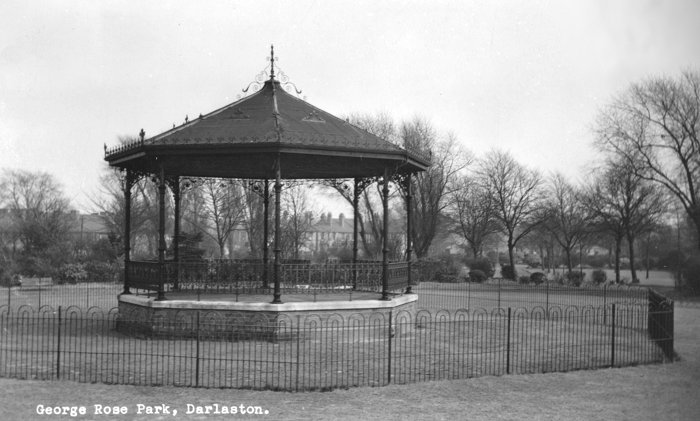
The bandstand. From an old
postcard.
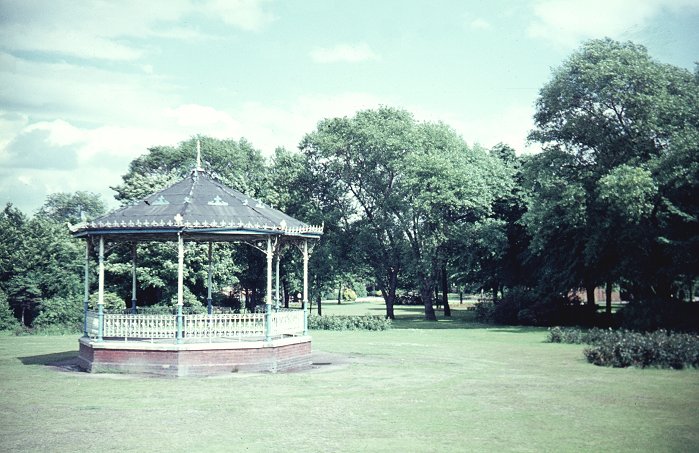
The bandstand on a sunny day.
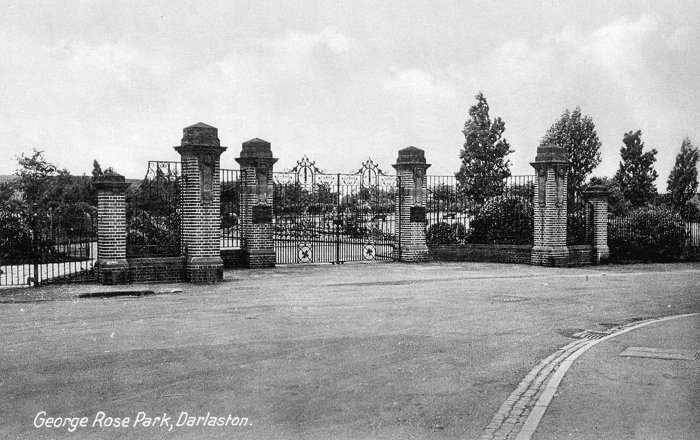
The front gates. From an old
postcard.
| The park was built on an old
mining area known as Herbert's Park, that consisted
wasteland, slag heaps, and pit mounds. The council paid
£2,000 for Herbert's Park, and £551 for an adjacent
piece of land. The project began in 1921 and took three
years to complete. Casual employment was found for over
700 unemployed people, who were paid from a special fund
amounting to £3,349, that was set aside for the purpose. Town Architect C. W. D. Joynson designed the park, in
which the old pit mounds were incorporated as grass
covered banks. On Saturday 29th March, 1924 a ceremony
was held at the nearly completed park. Hundreds of
people came along and 140 lime trees were planted by
individuals and organisations to form a walkway known as
Yardley Avenue, in recognition of Alderman Yardley's
services to the town. Councillor George Rose gave a
speech during which he said that football pitches,
cricket pitches, tennis courts, a bowling green, and a
children's playground would be provided. He also asked
for donations to cover the cost of a bandstand, a
shelter, and some seats.
It had been intended to add a swimming pool at a
later date, but it never materialised.
The park was formally opened in pouring rain on the
afternoon of Saturday 1st November, 1924. Sadly George
Rose died in August, 1924 and so didn't live to
see the opening. The park was named after him in
recognition of his help for the unemployed.
|
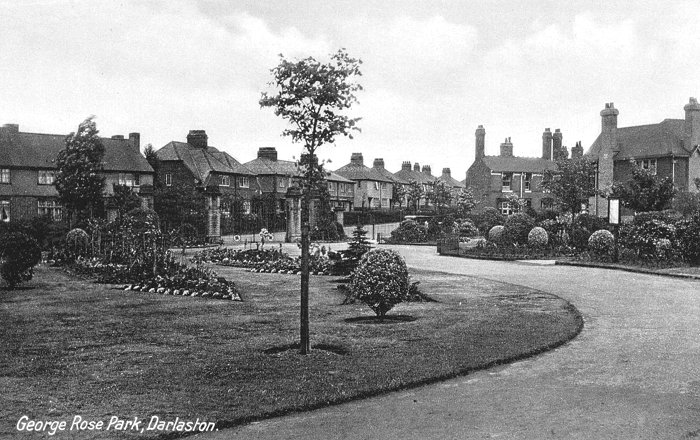
Another view of the park. From an
old postcard.
|
On the afternoon of the opening a large procession
headed by the town band made its way from the Town Hall
to the park. Alderman Yardley performed the opening
ceremony by unlocking the gates in Willenhall Street
with a silver key. In his speech he said:
The thoughts of all assembled here must inevitably
be tinged with sadness upon the reflection that the one
man who inspired the idea of the park and did so much to
bring the scheme to a successful issue, has not been
spared to witness the realisation of one of his most
treasured dreams. I refer of course to our late
Chairman. I am sure that you will agree with me when I
say that no more fitting memorial could be raised to his
memory than this park, which will ever be known as
George Rose Park and remain a permanent record of the
good work of one of Darlaston's most faithful and loyal
citizens.
After the opening, the procession reassembled and
made its way to the Owen Recreation Ground at Darlaston
Green.
The park covered 34 acres, and was created at a cost
of £16,000. |
|
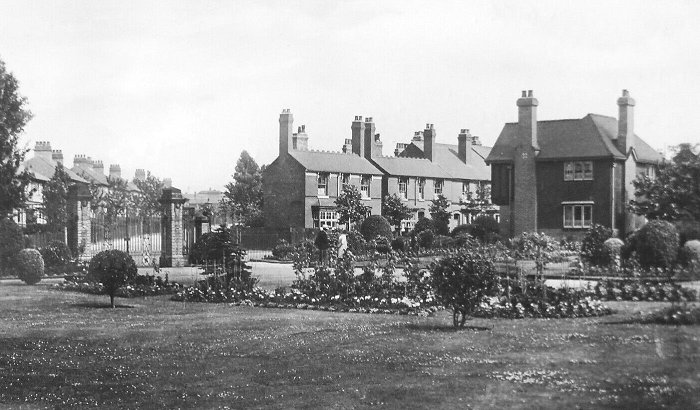
A final view of the park.
From an old postcard. |
|
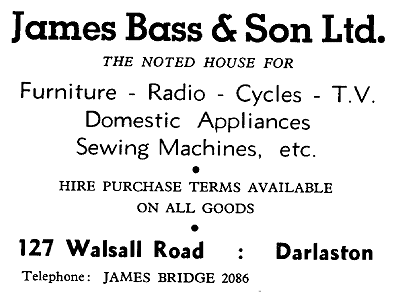
An advert from 1963. |
James Bass & Son Limited the well known Darlaston
furniture manufacturers were incorporated in 1928.
The company manufactured wooden school and office
furniture which sold throughout the country, and had an
extensive retail shop in Walsall Road.
James Bass
was also a local councillor. |
|
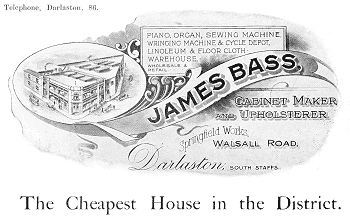
An advert from 1921. |
|
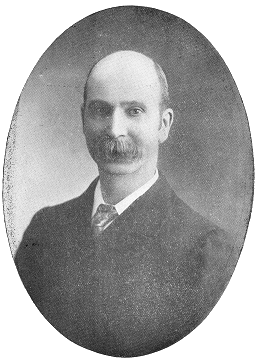
James Bass.
|
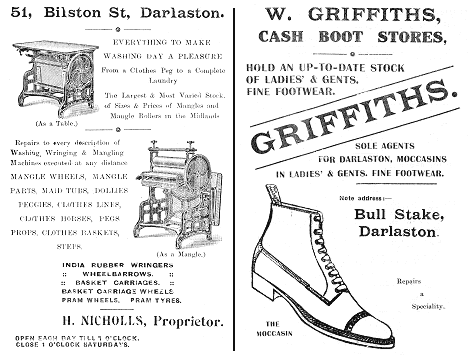
Two adverts from the early 1920s, when
most things could be purchased locally.
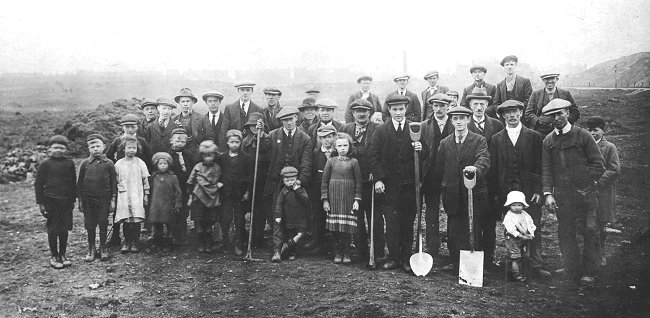
A lovely photograph showing a
group of people in their Sunday best, standing on an
area of derelict land off Dangerfield Lane in the early
1930s. They were using the land as an allotment. The
houses in the background are on Moxley Road, or
Woods Bank as it was known, and the chimney is part of
Longmore Brother's factory. On the right is part of
Dangerfield Lane, and the Lodge Holes Colliery spoil
heaps. The photo was taken near to the footpath that ran
from Dangerfield Lane to Holyhead Road, where Margaret
Road was later built. You can see the end of it on the
right. In the mid 1930s the area was redeveloped for
housing by Wednesbury Council. Photo courtesy of John &
Christine Ashmore.Lodge
Holes Colliery, like many of the local coal mines,
caused subsidence in the surrounding area. Before the
boundary changes in 1966, most of Dangerfield Lane,
including the site of Lodge Holes Colliery was in
Wednesbury. Some of the tunnels in the coal mine were
under Dangerfield Lane, which caused part of the road to
subside. Wednesbury Corporation was left with the job of
restoring the road to its original level to make it
useable again. On the 30th June, 1908, the Corporation
sought damages from the colliery owners to cover the
cost of the repairs to the road, including raising it to
its original level. The owners had refused to cover the
full cost, stating that it would be far cheaper to
repair the road, leaving it at the sunken level.
Wednesbury
Corporation went to the Court of Appeal in the Royal
Courts of Justice to force the colliery owners to pay
the full amount for the necessary work. The Corporation
were unsuccessful in their appeal and were told that the
sum of £80 offered by the colliery owners would be
sufficient. In order to restore the road to its original
level and to properly support it, involved the building
of an embankment and retaining walls, which cost the
Corporation around £400. |
| By the late 1920s the old Cock Street burial ground,
which had been disused since 1860 when James Bridge
Cemetery opened, had fallen into a state of disrepair.
In the early 1930s it was renovated by the Owen family
and reopened in 1932 as the Owen Memorial Garden,
dedicated to Alfred Ernest Owen. |
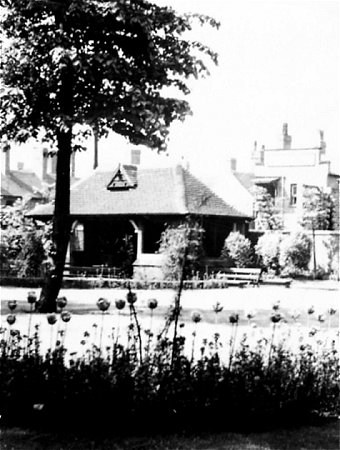 |
|
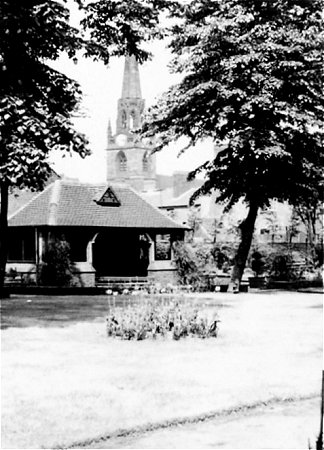 |
| Two views
of the Owen Memorial Garden photographed in the
late 1930s by the late W. J. Ashmore. Courtesy of John & Christine Ashmore. |
|
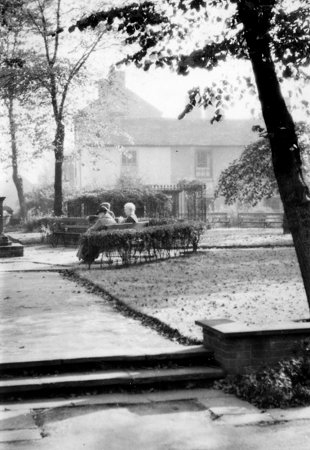 |
|
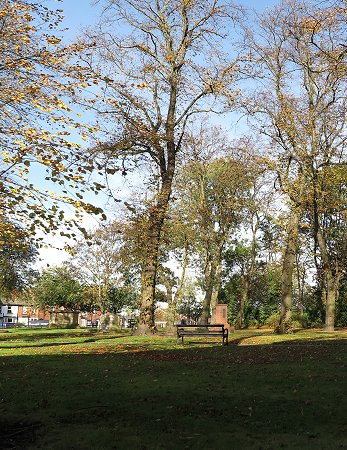 |
| Another of
the late W. J. Ashmore's photographs. Courtesy of John & Christine Ashmore. |
|
A modern view of the
garden on a sunny day in October, 2014. |
|
| The Bentley Hall Brick Company Ltd. was founded in
1933. Its high quality bricks were used by numerous
building contractors within about a thirty mile radius
of the town. They had an 80 acre site from which most of
the clay for the bricks was obtained.
The area had
previously been extensively mined and consisted of spoil
heaps from the numerous gin pits. Much of the clay came
from the spoil heaps and the production processes were
fully mechanised including a Hoffman continuous kiln
capable of drying over 200,000 bricks a week. |
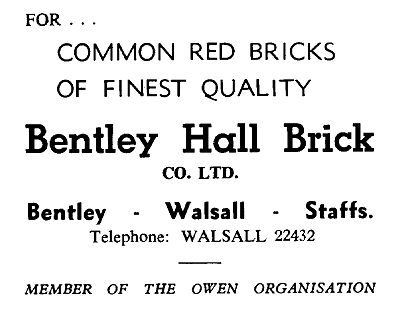
An advert from 1963. |
| Darlaston finally expanded to its present size on
the 1st of April 1934 when it took over the Parish of
Bentley as part of the Staffordshire Review Order. |
| A well-known name in Darlaston was Len Mitchell, who
had four shops in Pinfold Street. He lived at 62 Old
Park Road (now number 136), and started in business
around 1930, selling cycles and cycle accessories in a
shed, in his garden, next to the house.
After several
break-ins he moved the shop into his front room, and
traded from the house for a few years.
In 1934 he opened his first shop in Pinfold
Street, selling cycles and cycle accessories. |
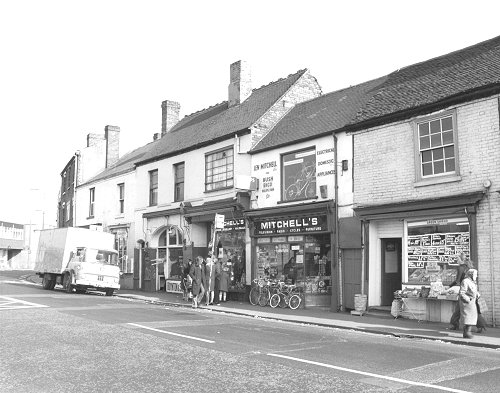
Two of Len Mitchell's shops in
Pinfold Street in the early 1970s. |
|
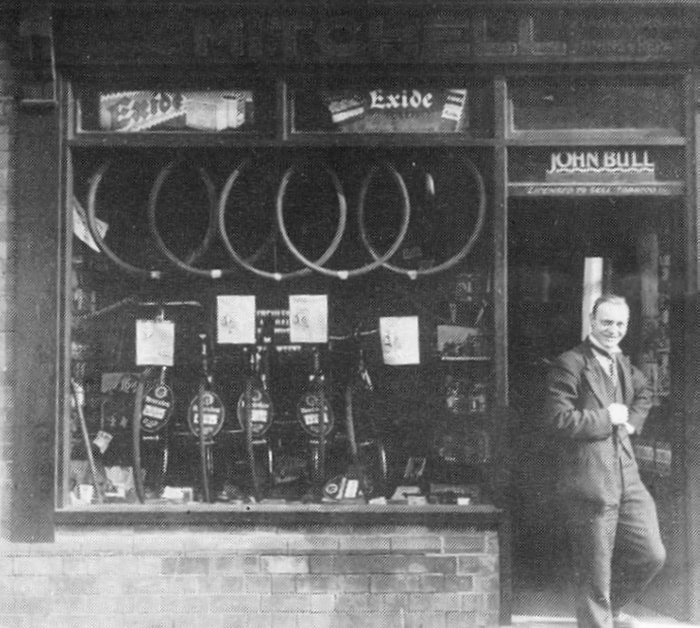
Len Mitchell in the
doorway of his shop in Old Park Road. |
| He became a dealer for some
well-known makes including B.S.A., Dawes, Defiance,
Hercules, Hopper, Phillips, Raleigh, and Triumph. Len
soon expanded into other areas, opening a pram shop,
selling a range of baby carriages, pushchairs, toys, and
bedding, and also carried out pram repairs. Two other
shops followed. One sold handbags, jewellery, and
fashion accessories. The other sold furniture, radios,
televisions, and electrical domestic appliances. He was
an agent for Bush, Murphy, Philips, and Pam. Items were
available for rental, or on hire-purchase. I remember going to the shop with my father to
purchase our first mains-powered radio, a Bush bakelite
model. I was 4 years old at the time. I also had a
child's tricycle that came from the shop.
It was a family-run business. Len's twin daughters,
Marion and Dorothy worked in the shops, as did Dorothy's
husband, Leslie Raffle, who managed the TV and radio
shop. Another employee, Ben Mills was Marion and
Dorothy's cousin. Other employees included Mary
Jennings, and Joan Marson.
Len Mitchell retired in 1963, and left the
running of the business to the other family members.
|
|
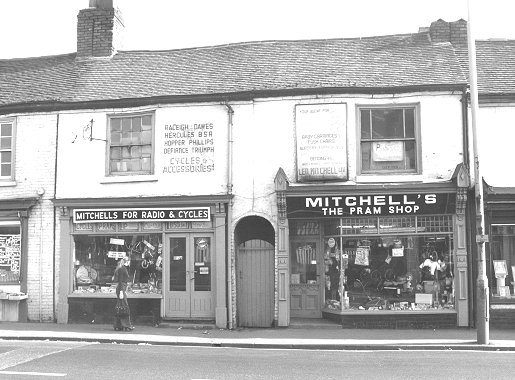
Len's other shops in Pinfold
Street. |
The shops closed in 1982 because of impending
demolition. At the time Walsall Council announced a
scheme to extend St. Lawrence Way through the shops
to join Darlaston Road. The scheme was soon
abandoned, and of course the shops are still there
today (October 2010). Len Mitchell died in 1987 at
the age of 88, and was survived by his wife, who
lived for another year. Dorothy Raffle died in
January 2000. The shops, which offered an important
local service, will be fondly remembered by many
people. |
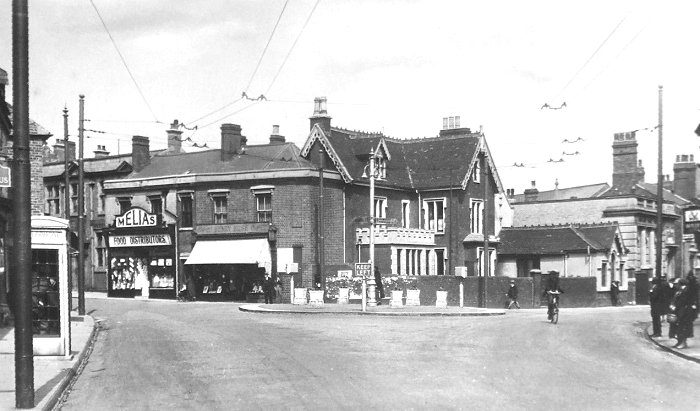
The Bull Stake. From an old postcard.
| A Silver Jubilee
The Silver Jubilee celebrations of King George V and
Queen Mary were held from 6th May to 12th May, 1935.
The streets were decked with bunting, street parties
were held for children, and musicians, and jazz
bands toured the town. Sporting events took place in
public parks, and an ox was roasted at Catherine's
Cross. On the evening of the 6th May, a large
bonfire was lit at The Flatts, on top of 'Sandy
Bank' where Darlaston Baths now stands. A parade
passed through the town to light the fire. It
included local councillors, torch bearers, members
of the territorial army, the 1st Moxley Scout Troop,
and the 2nd Darlaston Scout Troop. The fire was lit
by Councillor Harry Berry, of Hollydene, Slater
Street, Darlaston. |
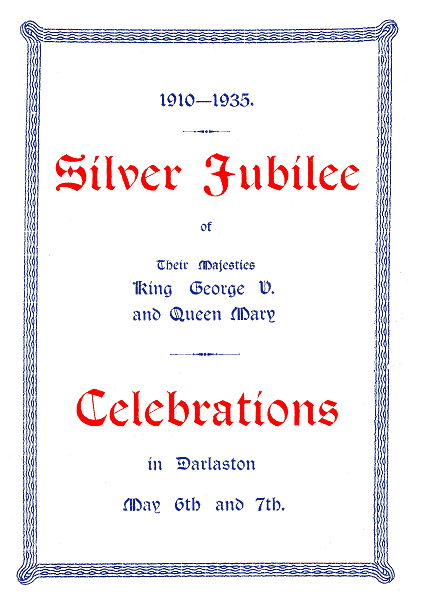
The programme for the events.
Courtesy of Christine and John Ashmore. |
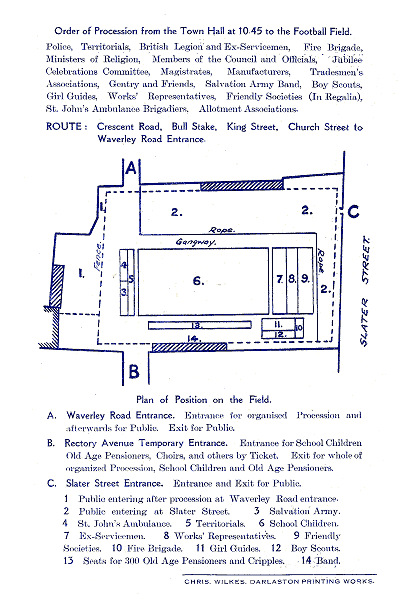
The first page of the
programme. Courtesy of Christine and John Ashmore. |
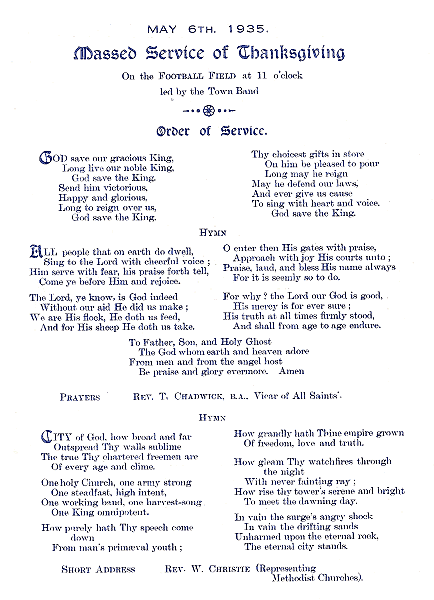
The next page of the
programme. Courtesy of Christine and John Ashmore. |
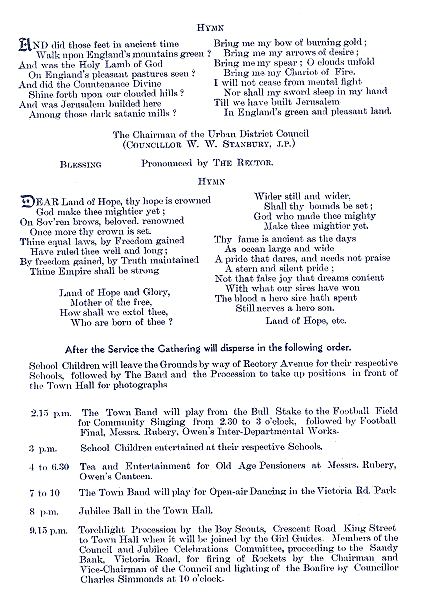
The last page of the
programme. Courtesy of Christine and John Ashmore. |
| A Coronation In 1937 Darlaston celebrated the coronation with
a procession through the town centre, followed by a
service at the football ground. |
|
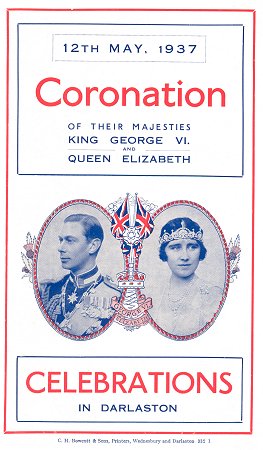
The programme for the
celebrations. |
|
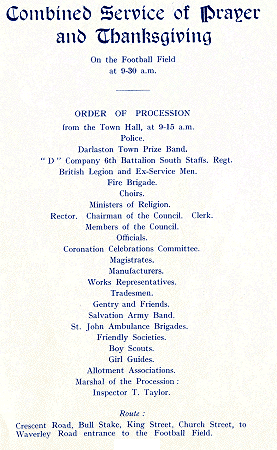
Details of the procession to
the football ground. |
|
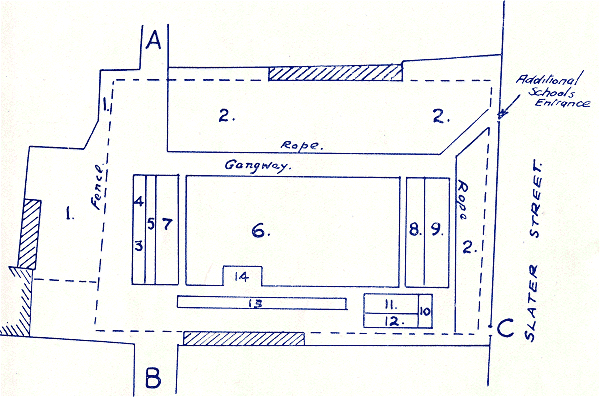
The layout for the
coronation service at the football ground.
|
A. |
|
The Waverley Road
entrance for the procession and the
public. |
|
B. |
|
Rectory Avenue
temporary entrance for school
children, old age pensioners,
choirs, and ticket holders. |
|
C. |
|
Slater Street
entrance for the public. |
|
1. |
|
Public entering
after the procession at the Waverley
Road entrance. |
|
2. |
|
Public entering at
Slater Street. |
|
3. |
|
Fire Brigade. |
|
4. |
|
St. John's
Ambulance Brigade. |
|
5. |
|
Ex-service men. |
|
6. |
|
School children. |
|
7. |
|
Territorials. |
|
8. |
|
Work's
representatives. |
|
9. |
|
Friendly societies. |
|
10. |
|
Salvation Army. |
|
11. |
|
Girl Guides. |
|
12. |
|
Boy Scouts. |
|
13. |
|
Seats for 300 old
age pensioners and disabled. |
|
14. |
|
Band. |
|
| The service was conducted by the Rev. L.
Robinson, representing Methodist churches,
the Rev. T. Chadwick, vicar of All Saints'
Church, Councillor W. G. Berry, chairman of
the council, and the Rev. A. B. Lavelle, the
Rector. Other events during the day included
the following: |
|
Time |
|
Event |
|
8.30 a.m. |
|
Gratuities to the unemployed, paid
at the Town Hall. |
|
9.00 a.m. |
|
Ringing of the Parish Church bells.
Also intermittently during the day. |
|
11.00 a.m. |
|
Broadcast service at the Parish
Church. |
|
2.15 p.m. |
|
Town Hall Band marched and played
from the Bull Stake to the football ground, arriving
in time for community singing at 2.30 p.m. Followed
by a football match and gymnastic display. |
|
3.00 p.m. |
|
School children assembled at their
respective schools for tea and entertainment. |
|
4.00 to 7.00 p.m. |
|
Tea and entertainment for old age
pensioners at Rubery Owen's canteen. |
|
7.00 to 10.00 p.m. |
|
The Town Hall Band played light
music at Victoria Park. |
|
9.00 p.m. |
|
Fairy lights at the Town Hall, and
Victoria Park, and floodlighting at the war
memorial. |
|
9.15 p.m. |
|
A torchlight procession by the Boy
Scouts, Girl Guides, members of the council, and the
coronation celebrations committee, through the town
centre to The Flatts for a bonfire and firework
display.
|
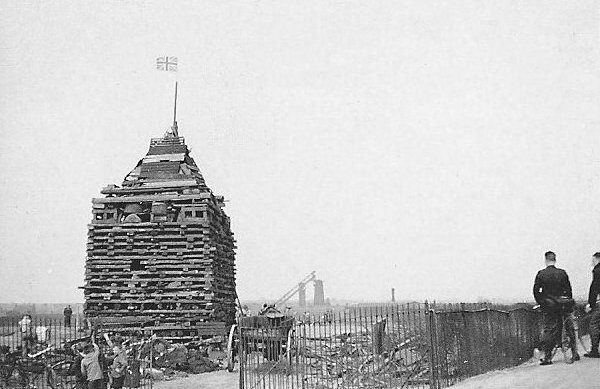
The impressive bonfire at The
Flatts on 12th May, 1937. Photographed by the late
W. J. Ashmore. Courtesy of John & Christine Ashmore. |
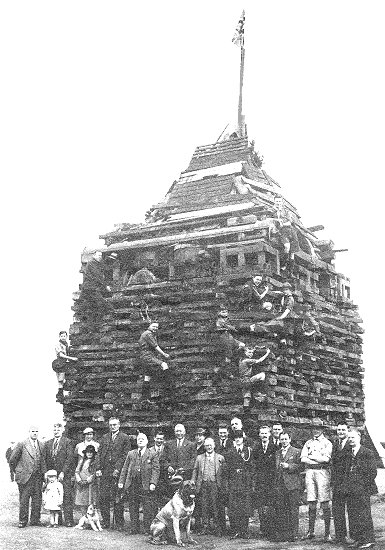 |
Officials and members of
the 1st Moxley Scout Troop pose for an official
photograph beside the bonfire. |
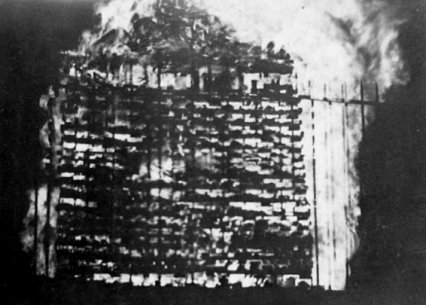 |
|
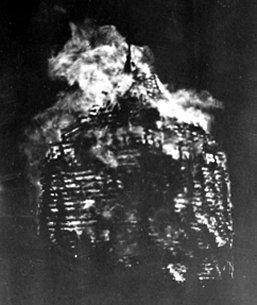 |
| Two
more views of the bonfire, also photographed
by the late W. J. Ashmore. Courtesy of John
& Christine Ashmore. |
|
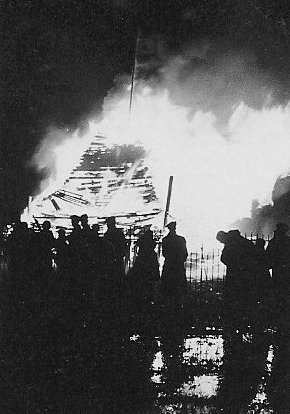 |
|
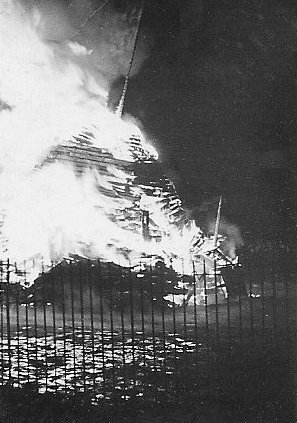 |
|
The
structure begins to collapse as the fire
takes hold. Photographed
by the late W. J. Ashmore. Courtesy of John
& Christine Ashmore. |
|
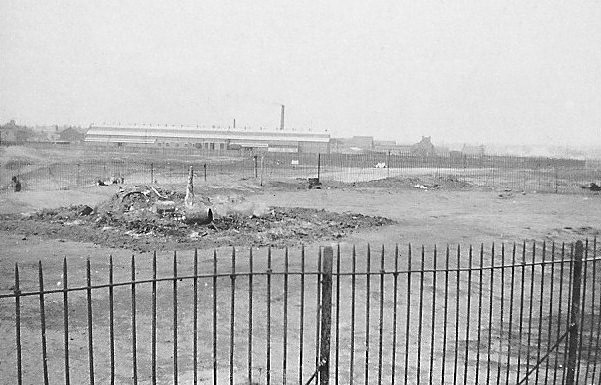
The aftermath of the bonfire.
Photographed by the late W. J. Ashmore. Courtesy of
John & Christine Ashmore. |
| |
|
|
|
|
| View a
list of Darlaston Streets and Occupants
from 1922 |
 |
|
View a Residential
Directory
from 1922 |
 |
| |
|
|
|
|
|
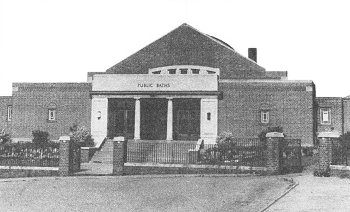
The old public baths. |
A notable event in 1938 was the opening of the
public baths in Victoria Road by the Earl of Harrowby.
The pool measured 100ft. by 35ft., and the depth varied
from 3ft. to 9ft. 3 inches. It held 133,000 gallons of
water, that was filtered, heated, aerated, and
sterilised at the rate of 35,000 gallons per hour.
Facilities existed for organised instruction in all
types of swimming, life saving, and water polo. |
| Considerable improvements were carried out in 1946
when the ceiling and upper parts of the walls were
fitted with acoustic tiles to reduce noise. In 1966 the
building was modernised at a cost of nearly £14,000 but
sadly it closed in 1993 due to lack of funds for
refurbishment, and stood in a derelict state for several
years. Funds were eventually raised for a replacement
swimming pool and the new baths opened in November 2000.
The award winning pool was designed by Hodder Associates
and Consulting Engineer Arup. |
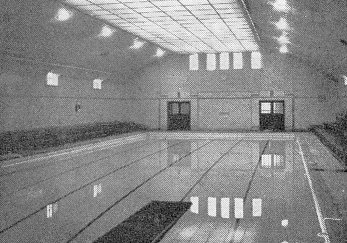
The interior of the baths in 1976. |
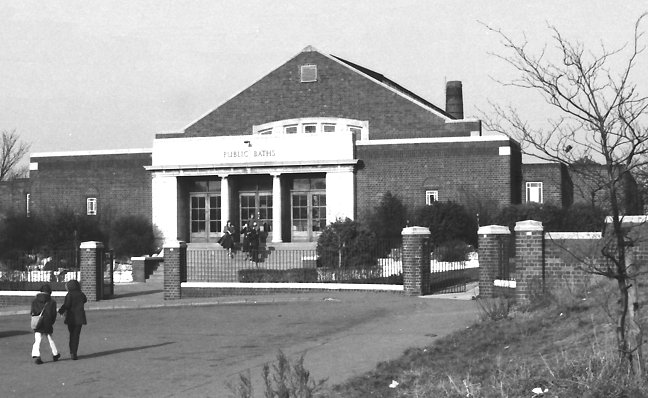
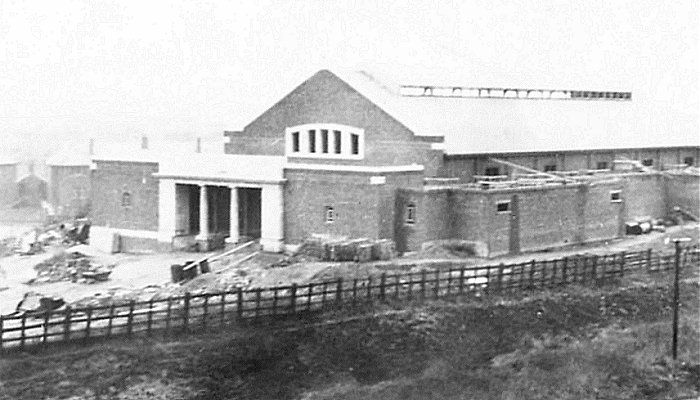
Building work at Darlaston Baths
in 1938. Photographed by the late W. J. Ashmore. Courtesy
of John & Christine Ashmore. |
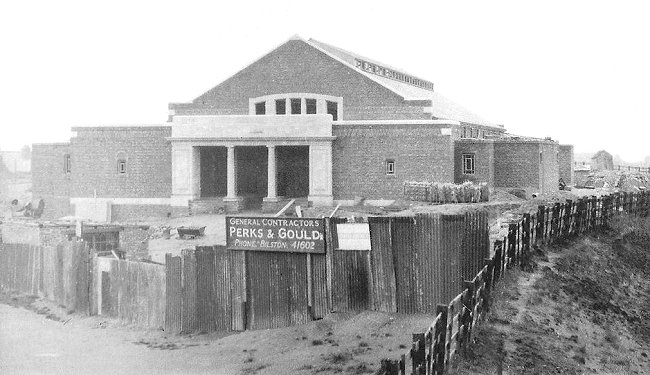
The baths, nearing completion in
1938. Photographed by the late W. J. Ashmore. Courtesy
of John & Christine Ashmore. |
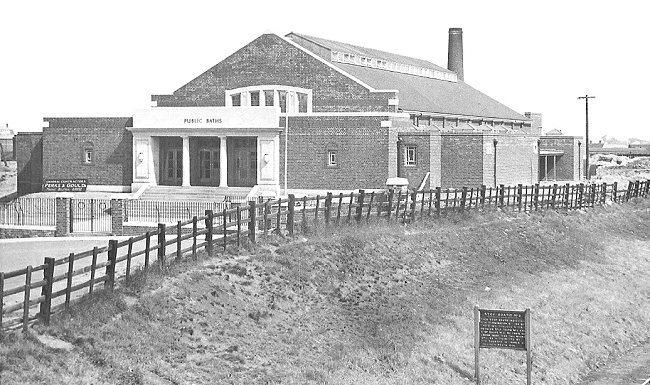
The completed baths. Photographed
in 1938 by the late W. J. Ashmore. Courtesy of John &
Christine Ashmore. |
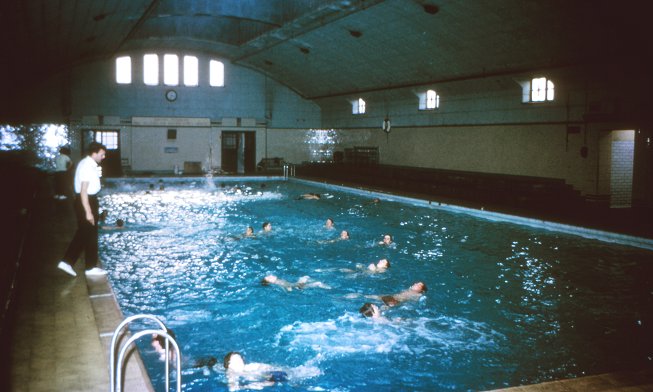
The interior of the baths in 1966.
| Views from Darlaston
Green in the late 1930s |

The eastern side of Rubery Street.
Photographed on Sunday 28th February, 1937 by the late
W. J. Ashmore. Courtesy
of John & Christine Ashmore. |
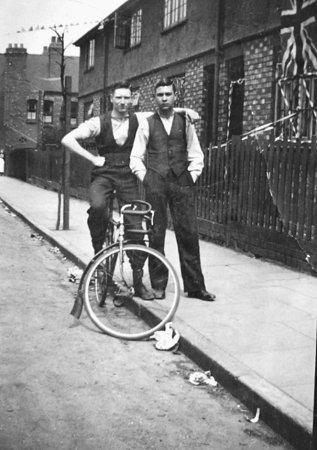 |
|
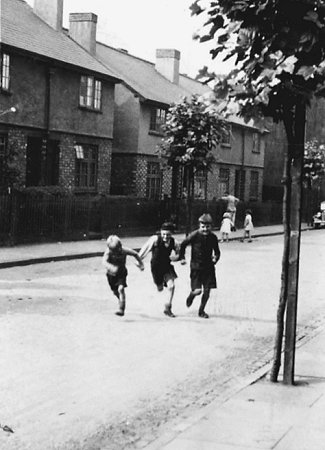 |
| Alf Peace
sitting on on his homemade bicycle in Rubery
Street. Possibly in 1937. Photographed by the
late W. J. Ashmore. Courtesy
of John & Christine Ashmore. |
|
Another view of Rubery
Street in the late 1930s. Photographed by the
late W. J. Ashmore. Courtesy
of John & Christine Ashmore. |
|
 |
|
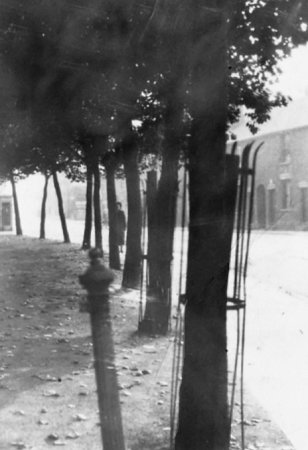 |
| Snow in
Beard Street. The cycle tracks were made by
postman Richard Ashmore, on his way to work.
Photographed by the late W. J. Ashmore. Courtesy
of John & Christine Ashmore. |
|
A final view of The Green.
Photographed by the late W. J. Ashmore. Courtesy
of John & Christine Ashmore. |
|
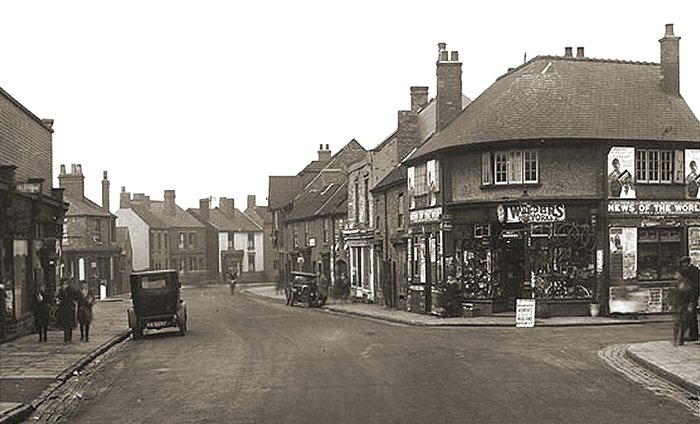
Blockall in the late 1920s. From an old
postcard.
 |
 |
 |
Return to
Cinemas |
Return to
Contents |
Proceed to
World War 2 |
|

